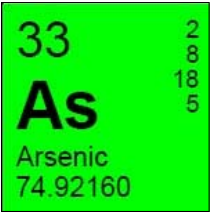Arsenic
View/Download PDF Version
What is Arsenic?
Arsenic occurs naturally in the earth’s crust at an average concentration of 2-5 parts per million (ppm), or 2-5 grains in a cup of sugar. Higher concentrations are often found around hot springs and other geothermal sources; mined ores like copper, gold, and zinc; and also in some areas with glacial geologic deposits. Arsenic is put to many beneficial uses in industry with about 90% of this use accounted for in wood preservative. The human health effects of arsenic have been extensively studied and it has been long recognized as a poison.
How does Arsenic get into Groundwater?
When groundwater flows through mineral deposits high in arsenic, the minerals can break down and release arsenic into the water. The arsenic concentration flowing out of Yellowstone National Park in the Madison River ranges up to more than 10 times the drinking water standard as a result of natural geothermal sources. Man made sources of arsenic also contaminate groundwater. Metal ores brought to the surface through mining can contain large amounts of arsenic. This arsenic can be released by bacteria in waste piles or can be released to the atmosphere during smelting. Uses of arsenic in industry include wood preservative, pesticides, glass production, and electronics production. All of these industrial uses pose potential threats to groundwater if not managed properly.
How much Arsenic is Too Much?
The US Environmental Protection Agency (USEPA) has set a drinking water standard for arsenic of 10 parts per billion (ppb). This is equivalent to 0.010 milligrams per liter (mg/L). This regulation only applies to public water supplies but the health implications are the same for private well owners. The 10 ppb standard represents the best available information for balancing health benefits with the costs of removing arsenic from drinking water. The USEPA has also set a Maximum Contaminant Level Goal (MCLG) of zero for arsenic. The goal is the ideal arsenic concentration without consideration of the removal cost.
Health Risks from Arsenic
A lethal dose of arsenic is in the neighborhood of 100 milligrams. It would take more than 250 gallons of arsenic contaminated water at 10 times the USEPA standard to kill someone immediately. The more likely type of health effect from arsenic comes from low dosages over a long period of time or “chronic” effects. These effects include skin problems, high blood pressure, circulatory system failure, diabetes, nervous system problems, low birth weight and cancer of the lungs, bladder, kidney, and liver. Whether someone will develop any of these conditions depends on the amount of arsenic consumed, the time of exposure, the form of the arsenic, and the general health or sensitivity of the person.
Arsenic Removal in the Home:
If your arsenic test result is above 0.01 mg/L you might wish to consider bringing in drinking water from another source or installing a home water treatment system. “Point of Use” treatment systems such as reverse osmosis, distillation, and adsorption (i.e. carbon or charcoal) systems can be installed on your kitchen sink to provide treated water for drinking and cooking. NSF International (see web address below) is a not-for-profit organization which tests and reviews drinking water treatment systems and provides information to the public about different technologies and their effectiveness.
Additional Resources
Click on the links below to be directed to more resources.
USGS Arsenic in US Groundwater
World Health Organization Arsenic Fact Sheet
NSF International: Home Water Treatment Devices
USEPA Drinking Water Contaminants
